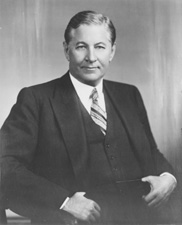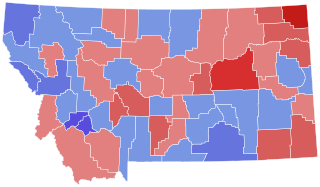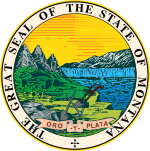
The 1978 United States Senate elections were held on November 7, in the middle of Democratic President Jimmy Carter's term. The 33 seats of Class 2 were contested in regular elections. Special elections were also held to fill vacancies.

The 1972 United States Senate elections were held on November 7, with the 33 seats of Class 2 contested in regular elections. They coincided with the landslide re-election of Republican President Richard Nixon. Despite Nixon's landslide victory, Democrats increased their majority by two seats. The Democrats picked up open seats in Kentucky and South Dakota, and defeated four incumbent senators: Gordon Allott of Colorado, J. Caleb Boggs of Delaware, Jack Miller of Iowa, and Margaret Chase Smith of Maine. The Republicans picked up open seats in New Mexico, North Carolina, and Oklahoma, and defeated one incumbent, William B. Spong Jr. of Virginia.

The 2014 United States Senate elections were held on November 4, 2014. A total of 36 seats in the 100-member U.S. Senate were contested. Thirty-three Class 2 seats were contested for regular six-year terms to be served from January 3, 2015, to January 3, 2021, and three Class 3 seats were contested in special elections due to Senate vacancies. The elections marked 100 years of direct elections of U.S. senators. Going into the elections, 21 of the contested seats were held by the Democratic Party, while 15 were held by the Republican Party.

The 1918 United States Senate election in Montana took place on November 5, 1918. Incumbent United States Senator Thomas J. Walsh, who was first elected to the Senate in 1912, ran for re-election. He won the Democratic primary uncontested, and was opposed in the general election by Oscar M. Lanstrum, a former State Representative and the Republican nominee, and Jeannette Rankin, one of two United States representatives from Montana's at-large congressional district and the nominee of the National Party. Walsh narrowly won his second term in the Senate.

The 1982 United States Senate election in Montana took place on November 2, 1982. Incumbent United States Senator John Melcher, who was first elected to the Senate in 1976, opted to run for re-election. He won the Democratic primary after he faced a tough intraparty challenger, and advanced to the general election, where he faced Larry R. Williams, an author and the Republican nominee, and Larry Dodge, the Libertarian nominee. Though his margin was reduced significantly from his initial election, Melcher still comfortably won re-election to his second and final term in the Senate.

The 1930 United States Senate election in Montana took place on November 4, 1930. Incumbent United States Senator Thomas J. Walsh, who was first elected to the Senate in 1912, and re-elected in 1918 and 1924, ran for re-election. He won the Democratic primary unopposed, and faced Montana Supreme Court Associate Justice Albert J. Galen, the Republican nominee, and several independent opponents in the general election. Ultimately, Walsh defeated his opponents in a landslide and won his fourth and final term in the Senate.

The 1948 United States Senate election in Montana took place on November 2, 1948. Incumbent United States Senator James E. Murray, who was first elected to the Senate in a special election in 1934 and was re-elected in 1936 and 1942, ran for re-election. After winning the Democratic primary, he faced Tom J. Davis, an attorney and the Republican nominee, in the general election. Following a narrow re-election in 1936, Murray significantly expanded his margin of victory and comfortably won re-election over Davis, resulting in him winning his fourth term and his third full term in the Senate.

The 1954 United States Senate election in Montana took place on November 2, 1954. Incumbent United States Senator James E. Murray, who was first elected to the Senate in a special election in 1934 and was re-elected in 1936, 1942, and 1948, ran for re-election. After winning the Democratic primary against trivial opponents, he advanced to the general election, where he was opposed by Wesley A. D'Ewart, the Republican nominee and the United States Congressman from Montana's 2nd congressional district. A contentious and close election ensued, but ultimately, Murray was able to narrowly win re-election over D'Ewart to a final term in the Senate.

The 1960 United States Senate election in Montana took place on November 8, 1960. Incumbent United States Senator James E. Murray, who was first elected to the Senate in a special election in 1934 and was re-elected in 1936, 1942, and 1948, and 1954, declined to seek re-election, creating an open seat. United States Congressman Lee Metcalf won out in a crowded Democratic primary and faced off against former United States Congressman Orvin B. Fjare, who won in a similarly-crowded Republican primary. Following a close general election, Metcalf narrowly defeated Fjare to win his first term in the Senate.

The 1966 United States Senate election in Montana took place on November 8, 1966. Incumbent United States Senator Lee Metcalf, who was first elected to the Senate in 1960, ran for re-election. He won the Democratic primary uncontested, and moved on to the general election, where he was opposed by Tim M. Babcock, the Republican nominee and the Governor of Montana. Though the race remained close, Metcalf was able to expand on his 1960 margin of victory, and defeated Babcock to win a second term.

The 1978 United States Senate election in Montana took place on November 7, 1978. Following the death of United States Senator Lee Metcalf on January 12, 1978, Montana Supreme Court Chief Justice Paul G. Hatfield was appointed to serve for the remainder of Metcalf's term. Hatfield opted to run for a full term, but was overwhelmingly defeated in the Democratic primary by U.S. Representative Max Baucus of the 1st congressional district. Baucus advanced to the general election, where he was opposed by the Republican nominee, author Larry R. Williams. Baucus ended up defeating Williams by a solid margin to win his first term in the Senate, and, following Hatfield's resignation on December 12, 1978, he began serving his first term in the Senate.

The 1984 United States Senate election in Montana took place on November 6, 1984. Incumbent United States Senator Max Baucus, who was first elected in 1978, ran for re-election. He easily won renomination in the Democratic primary, and advanced to the general election, where he faced Chuck Cozzens, a former State Representative and the Republican nominee. Despite President Ronald Reagan's strong performance in the state that year, Baucus was able to easily win a second term over Cozzens.

The 1990 United States Senate election in Montana took place on November 6, 1990. Incumbent United States Senator Max Baucus, who was first elected in 1978 and was re-elected in 1984, ran for re-election. After winning the Democratic primary, he moved on to the general election, where he was opposed by Allen Kolstad, the Lieutenant Governor of Montana and the Republican nominee. Baucus ultimately ended up defeating Kolstad in a landslide, winning his third term with ease.

The 1922 United States Senate election in Montana took place on November 7, 1922. Incumbent United States Senator Henry L. Myers, who was first elected to the Senate in 1910, and was re-elected in 1916, declined to seek re-election. Former United States Attorney Burton K. Wheeler won the Democratic primary and advanced to the general election, where he faced Carl W. Riddick, the United States Congressman from Montana's 2nd congressional district and the Republican nominee. Ultimately, Wheeler defeated Riddick comfortably and won his first term in the Senate.

The 1940 United States Senate election in Montana took place on November 5, 1940. Incumbent United States Senator Burton K. Wheeler, who was first elected to the Senate in 1922, and was re-elected in 1928 and 1934, ran for re-election. Though he faced a serious challenger in the Democratic primary, he emerged victorious, and advanced to the general election, where he faced E. K. Cheadle, a state district judge and the Republican nominee. Just like in 1934, Wheeler won re-election in a landslide, winning his fourth term in the Senate.

The 1946 United States Senate election in Montana took place on November 5, 1946. Incumbent United States Senator Burton K. Wheeler, who was first elected to the Senate in 1922, and was re-elected in 1928, 1934, and 1940, ran for re-election. He was challenged in the Democratic primary by Leif Erickson, the Chief Justice of the Montana Supreme Court, and, following a close election, was narrowly defeated by Erickson. In the general election, Erickson faced State Senator Zales Ecton, the Republican nominee. Ultimately, Ecton defeated Erickson by a fairly wide margin, winning his first and only term in the Senate. Another Republican would not be elected Senator from Montana until 42 years later, when Conrad Burns narrowly won the 1988 election.

The 1958 United States Senate election in Montana took place on November 4, 1958. Incumbent United States Senator Mike Mansfield, who was first elected to the Senate in 1952, ran for re-election. Mansfield won the Democratic primary comfortably, and moved on to the general election, where he was opposed by Lou W. Welch, a millworker and the Republican nominee. In contrast to the close campaign in 1952, Mansfield defeated Welch in a landslide and won his second term in the Senate easily.

The 1964 United States Senate election in Montana took place on November 3, 1964. Incumbent United States Senator Mike Mansfield, who was first elected to the Senate in 1952 and was re-elected in 1958, ran for re-election. Mansfield won the Democratic primary in a landslide, and advanced to the general election, where he faced Alex Blewett, the Majority Leader of the Montana House of Representatives and the Republican nominee. Though Mansfield's margin was quite reduced from 1958, he still overwhelmingly defeated Blewett and won his third term in the Senate in a landslide.

The 1970 United States Senate election in Montana took place on November 3, 1970. Incumbent U.S. Senator Mike Mansfield, the sitting Senate majority leader who was first elected to the Senate in 1952 and was re-elected in 1958 and 1964, ran for re-election. Mansfield won the Democratic primary against several opponents, and advanced to the general election, where he was opposed by Harold E. Wallace, a sporting goods salesman and the Republican nominee. While his margin of victory decreased slightly from 1964, Mansfield still managed to defeat Wallace in a landslide, winning his fourth and final term in the Senate.

The 1972 Montana gubernatorial election took place on November 7, 1972. Incumbent Governor of Montana Forrest H. Anderson, who was first elected in 1968, declined to seek re-election. Thomas Lee Judge, the Lieutenant Governor of Montana, won a competitive Democratic primary, and moved on to the general election, where he faced Ed Smith, a rancher and the Republican nominee. Although then-President Richard Nixon won the state in a landslide in that year's presidential election, Judge managed to handily defeat Smith, winning his first of two terms as governor.




















